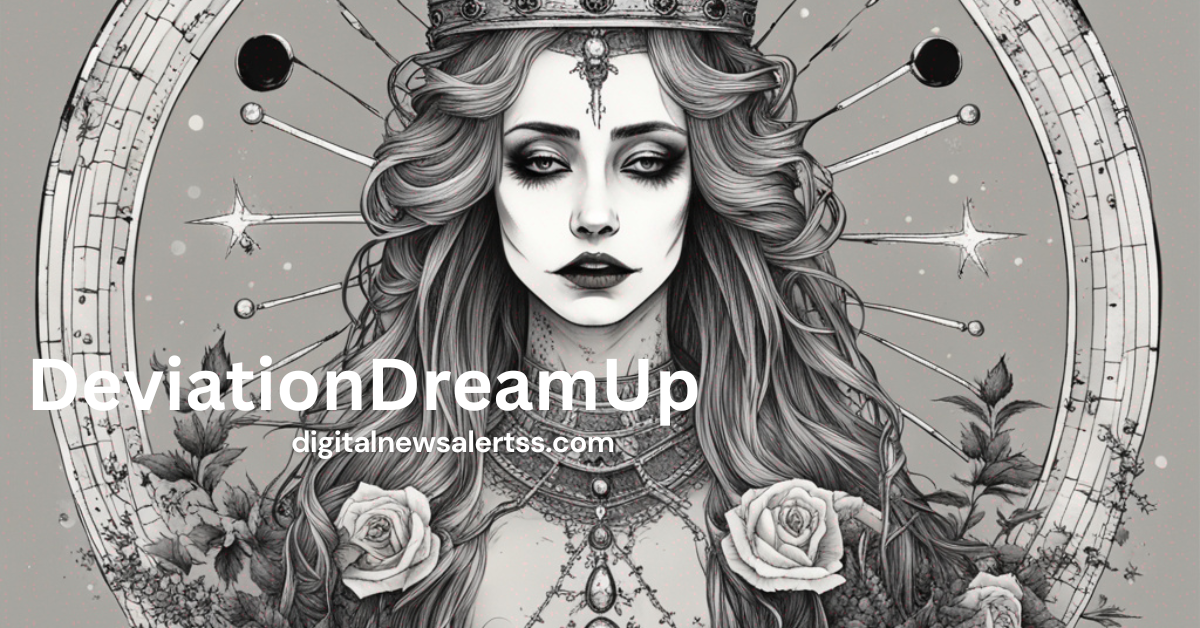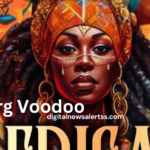In the ever-evolving world of art and technology, a groundbreaking tool has emerged that’s changing the way we think about creative expression. DeviationDreamUp, an innovative AI-powered platform, is revolutionizing the art world by blending human creativity with artificial intelligence. This article dives deep into what DeviationDreamUp is, how it works, and why it’s causing such a stir in artistic communities around the globe.
What is DeviationDreamUp?
DeviationDreamUp is a cutting-edge AI art generator that allows users to create stunning visual artwork using text prompts. By harnessing the power of machine learning algorithms, this platform can transform written descriptions into unique, high-quality images. Whether you’re a professional artist looking to expand your toolkit or a curious beginner eager to explore the world of digital art, DeviationDreamUp offers an accessible and exciting way to bring your imaginative visions to life.
How DeviationDreamUp Works
At its core, DeviationDreamUp uses advanced natural language processing and image generation techniques to interpret text inputs and create corresponding visuals. Here’s a simplified breakdown of the process:
1. Text Input: Users provide a detailed description of the image they want to create.
2. AI Analysis: The system analyzes the text, breaking it down into key concepts, themes, and visual elements.
3. Image Generation: Using its vast database of artistic styles and visual information, the AI generates an image that matches the description.
4. Refinement: Users can adjust parameters or provide additional prompts to fine-tune the result.
5. Final Output: The platform produces a high-resolution image ready for use or further editing.
The Magic Behind DeviationDreamUp
DeviationDreamUp’s success lies in its sophisticated AI model, which has been trained on millions of images and their associated descriptions. This extensive dataset allows the system to understand complex relationships between words and visual elements, enabling it to create images that are not just accurate representations of the text prompts, but also artistically compelling.
The platform uses a type of AI called a generative adversarial network (GAN), which consists of two neural networks working in tandem. One network generates images, while the other evaluates them, pushing the generator to create increasingly realistic and aesthetically pleasing results.
Why DeviationDreamUp Matters
Democratizing Art Creation
One of the most significant impacts of DeviationDreamUp is its ability to democratize art creation. By removing technical barriers, it allows individuals with vivid imaginations but limited artistic skills to bring their ideas to visual life. This democratization opens up new avenues for creative expression and storytelling across various fields.
Enhancing Professional Workflows
For professional artists and designers, DeviationDreamUp serves as a powerful brainstorming and conceptualization tool. It can quickly generate multiple variations of an idea, speeding up the creative process and inspiring new directions that might not have been considered otherwise.
Pushing the Boundaries of AI and Art
DeviationDreamUp represents a significant step forward in the ongoing conversation about the relationship between AI and human creativity. It challenges our understanding of authorship and raises intriguing questions about the future of art in an increasingly AI-driven world.
Getting Started with DeviationDreamUp
If you’re eager to try DeviationDreamUp for yourself, here’s a quick guide to getting started:
1. Sign Up: Visit the official DeviationDreamUp website and create an account.
2. Explore the Interface: Familiarize yourself with the platform’s user-friendly interface.
3. Craft Your Prompt: Write a detailed description of the image you want to create. Be specific about elements like style, color, mood, and composition.
4. Generate and Refine: Click the generate button and watch as DeviationDreamUp brings your vision to life. Use the refinement tools to adjust the result if needed.
5. Save and Share: Once satisfied, save your creation and share it with the world!
Tips for Crafting Effective Prompts
To get the most out of DeviationDreamUp, consider these tips for writing effective prompts:
1. Be Specific: The more detailed your description, the closer the output will match your vision.
2. Use Descriptive Language: Include vivid adjectives and specific nouns to guide the AI.
3. Mention Art Styles: Reference specific artistic movements or styles to influence the aesthetic.
4. Include Composition Details: Describe the layout, focal points, and overall structure of your desired image.
5. Experiment with Combinations: Try unexpected combinations of elements to spark unique creations.
The Impact of DeviationDreamUp on Various Industries
Art and Illustration
In the world of traditional art and illustration, DeviationDreamUp is both a disruptive force and a powerful ally. It’s enabling illustrators to quickly prototype ideas and explore new styles. Some artists are incorporating AI-generated elements into their work, creating hybrid pieces that blend human and machine creativity.
Advertising and Marketing
Marketing teams are leveraging DeviationDreamUp to rapidly generate visual content for campaigns. This speed and versatility allow for more dynamic and responsive marketing strategies, with the ability to quickly adapt visuals to changing trends or audience preferences.
Game Development
Game designers are using DeviationDreamUp to conceptualize characters, environments, and props. This tool is particularly valuable in the early stages of development, allowing teams to visualize and iterate on ideas quickly before committing resources to full production.
Film and Animation
Storyboard artists and concept designers in the film and animation industries are finding DeviationDreamUp to be an invaluable asset. It allows for rapid visualization of scenes and characters, helping to streamline the pre-production process.
Education
In educational settings, DeviationDreamUp is being used to create engaging visual aids and to teach students about the intersection of technology and creativity. It’s also sparking discussions about digital literacy and the role of AI in society.
The Future of DeviationDreamUp and AI Art
As DeviationDreamUp continues to evolve, we can expect to see even more sophisticated and nuanced outputs. Future iterations may include:
1. Enhanced User Control: More granular control over specific elements of the generated images.
2. Animation Capabilities: The ability to generate short animations or moving images from text descriptions.
3. 3D Model Generation: Expanding beyond 2D images to create 3D models for use in virtual reality and augmented reality applications.
4. Collaborative Features: Tools that allow multiple users to work together on a single creation, blending ideas and styles.
5. Integration with Other Creative Tools: Seamless compatibility with popular digital art and design software.
Ethical Considerations and Challenges
While DeviationDreamUp offers exciting possibilities, it also raises important ethical questions:
Copyright and Ownership
As AI-generated art becomes more prevalent, questions of copyright and ownership become increasingly complex. Who owns the rights to an image created by AI based on a user’s prompt?
Authenticity and Artistic Value
There’s ongoing debate about the artistic value of AI-generated art. Does the involvement of AI diminish the authenticity or emotional impact of a piece?
Job Displacement Concerns
Some worry that tools like DeviationDreamUp could potentially replace human artists in certain sectors. However, many argue that AI will serve as a complement to human creativity rather than a replacement.
Bias in AI Systems
Like all AI systems, DeviationDreamUp may reflect biases present in its training data. It’s crucial to continually assess and address any potential biases in the generated content.
Conclusion: The Art of Tomorrow, Today
DeviationDreamUp represents a significant leap forward in the fusion of technology and creativity. By democratizing art creation and pushing the boundaries of what’s possible, it’s opening up new horizons for artists, designers, and creators across various fields. While it raises important questions about the nature of art and creativity in the digital age, it also offers exciting possibilities for innovation and expression.
As we continue to explore the potential of AI in art, tools like DeviationDreamUp will undoubtedly play a crucial role in shaping the creative landscape of the future. Whether you’re an artist, a technologist, or simply someone fascinated by the intersection of human ingenuity and artificial intelligence, DeviationDreamUp offers a glimpse into a world where the boundaries of imagination are constantly expanding.
FAQs About DeviationDreamUp
Is DeviationDreamUp free to use?
DeviationDreamUp offers both free and paid tiers. The free version typically has limitations on the number of generations or image resolution, while paid subscriptions offer more features and higher quality outputs.
Can I use images created with DeviationDreamUp commercially?
The usage rights for AI-generated images can be complex. It’s best to check DeviationDreamUp’s specific terms of service and consider consulting with a legal professional for commercial use cases.
Do I need artistic skills to use DeviationDreamUp?
No artistic skills are required to use DeviationDreamUp. The platform is designed to be user-friendly and accessible to people with varying levels of artistic experience.
How accurate is DeviationDreamUp in interpreting text prompts?
While DeviationDreamUp is highly sophisticated, the accuracy of interpretation can vary. The more specific and detailed your prompt, the closer the output is likely to match your vision.
Can DeviationDreamUp create images in specific art styles?
Yes, DeviationDreamUp can generate images in various art styles. You can specify styles in your prompt, such as “in the style of Van Gogh” or “art deco poster design.”
Is it possible to edit or refine images after they’re generated?
DeviationDreamUp typically allows for some level of refinement through additional prompts or parameter adjustments. For more detailed editing, you may need to use separate image editing software.
How does DeviationDreamUp compare to other AI art generators?
DeviationDreamUp is one of many AI art generators available. Its specific strengths and features may vary compared to other platforms. It’s worth exploring multiple options to find the one that best suits your needs.
Can DeviationDreamUp generate realistic images of people?
While DeviationDreamUp can create human-like figures, it’s important to note that these are AI-generated and not representations of real individuals. There may be limitations or ethical considerations regarding the creation of realistic human images.
How often is DeviationDreamUp updated with new features?
The frequency of updates can vary. It’s best to check the official DeviationDreamUp website or follow their social media channels for the most up-to-date information on new features and improvements.
Can DeviationDreamUp be used for educational purposes?
Yes, many educators are incorporating AI art tools like DeviationDreamUp into their curricula to teach about technology, creativity, and digital literacy. However, it’s important to use such tools responsibly and in compliance with educational guidelines.



